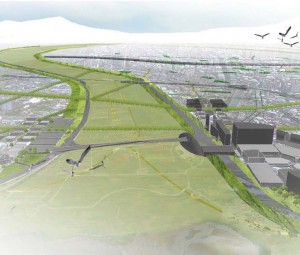大台北:多孔性城市 / GRAND TAIPEI: THE POROUS CITY

這是一個「設計式研究/研究式設計」的規劃經驗;同時也是一個「策略式規劃」的過程。我們思考永續社區發展的三個主要面向:(交通)基礎建設、水資源和(再生)能源。藉由研究結果擬定規劃策略,並轉化為環境規劃的元素,落實為實質的環境品質。 我們的企圖是在本規劃案中,以一個社區的尺度作為自給自足的單元,並期望應用到整個金門島上。金門是一個相對於台灣為小尺度的島嶼,因此達成環境永續策略所需投資的建設規模相對的小,也就容易達成。島嶼本身又是一個在地理上、認同上都容易與外界切分的領域,因此也較易突顯出自給自足的意象。 低碳排環境潛力的研究分析,對金門全島的環境資源做出整理: 2)水資源: 3)再生能源: 低碳排社區不能僅是零星的展覽與示範,而要以實踐來作為驗證。我們以統計數據的研究調查作為基礎,提出幾乎是令人驚訝的預期效果,以達能夠說服地方政府,甚至是地方民眾接納這樣的提案。要夢想成真,其實並不難,但是得先相信它。 在後續的計畫中,我們希望回頭檢驗我們的提案實踐後的效果,並了解應該改進的細節。長期的則希望能應用在金門全島,以一個細胞單元的概念,成就一個低碳排的島嶼示範區。 This is an example of ‘design by research’ and ‘research by design’ process. We especially concern three aspects: mobility infrastructure, water management and green energy. The master plan is base on the strategies resulted from research process. The master plan for the community is to create a self-sufficient unit in respect of mobility, water and energy. The same idea can be applied to the whole isle of Kinmen. Hence, whole Kinmen can be self-sufficient. In the analysis, we have some conclusions: 2. Water 3. Energy It is not impossible to have a net-zero community in Kinmen concerning the technology support. What matters is the policy that really go for it. The effect is generated in our research proposal. Unfortunately, we were not able to put this proposal into practice. There are many other concerns and interests involved. However, this experience gets our team deeper into the subject and we did learn from this. In a long term, the concept of a self-sufficient unit can still be the inspiration for a net-zero isle, Kinmen.
歐洲都市學碩士研究學位論文
規劃設計
黃冠中
梁桂瑛、王學治
顧問
業主
金門縣金沙鄉公所
地點
金門縣金沙鎮
規劃規模
面積/8000 (m2)
規劃內容
綠色運具轉運站
再生能源示範區
觀光導覽設施
規劃期間
2010~2011
分類
規劃、後工業遺址、
軍事設施再利用、
低碳排社區、
綠色交通、再生能源、
水資源
1)交通基礎建設:
金門的都市發展並非高度集中,因而提出多向性慢鄉交通網概念,提倡以電動車、自行車取代現有需耗油的交通工具。架構在既有路網上的節點式交通補給站設計,提供了較為機動、輕量的交通方式。
金門雖四面環海,但因季節性降雨明顯,且島嶼地形儲水不易,使得水資源分配不均。我們提出分散式的儲水單元,紓解集中式儲水的壓力。
金門地區強勁風力和日照,提供了碧山社區使用替代性能源的機會。再利用的靶場有廣闊的空間提供太陽能板鋪設、周圍起伏的山丘則是風力發電的絕佳場所。規模較小所以較易達成,同時也示範了趨零碳排規劃需求和效益。更進一步地,再生能源發點不僅足以自給自足,甚是成為產業轉型的另一個選項。
Degree design thesis for
European mastern on Urbanism
Planning
KC Huang
KY Lian, SC Wang
Consultant
Client
Township government of kinsa town
Location
Kinsa town, Kinmen,Taiwan ROC
Dimension
area/8000 (m2)
Program
Green Transportation Hub
Green Energy
Tourist Facility
Planning Period
2010~2011
Category
Planning, brown filed,
regeneration,
post-military facility,
net-zero community,
green transportation,
green energy,
water management
1. Mobility
The mobility network in Kinmen is not concentric, so does urbanization. In response, we propose an isotropic slow network base on bicycle and electronic vehicles in order to replace the fuel based vehicles. Several supply nodes for water and electricity are chosen to support the system.
Ironically, Kinmen isle is lack of water due to seasonal precipitation and the topographical condition. We propose a distributed water storage system to cover the concentric water reservoirs.
Strong sunshine and wind provide the opportunity to build up green energy system in Kinmen. There is adequate space for solar panel and windmill to generate energy in the planning site. With sufficient equipment, it is possible to have a net-zero energy community proposed here. On the economic side, the energy industry can also be the substitute for agriculture.

